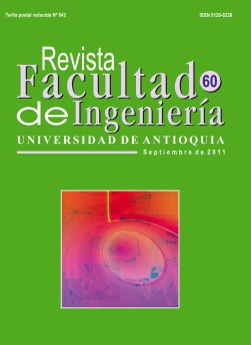Analysis of nonlinear dependences using artificial neural networks
DOI:
https://doi.org/10.17533/udea.redin.13672Keywords:
autoregressive neural network, nonlinear time series modelling, multiple correlation, analysis of correlation in nonlinear systemsAbstract
In this paper, we develop a new technique for detecting nonlinear dependences in time series, based on the use of an autoregressive neural network and the concept of coefficient of correlation. Taking into account that the employed neural network model is able to approximate any function in a compact domain, the proposed measures are able to detect nonlinearities in the data. Our technique is tested for various simulated and real datasets, and compared with classical functions of simple and partial autocorrelations; the results show that the in the linear cases the proposed measures have a similar behaviour to the simple and partial autocorrelations, but in the nonlinear cases they are able to detect other nonlinear relationships.
Downloads
References
N. Kasabov. Foundations of Neural Networks, Fuzzy Systems, and Knowledge Engineering. 2nd ed. Ed. Massachusetts Institute of Technology. 1998. pp. 43- 47.
A. Weigend, N. Gershfeld. Time-Series Prediction: Forecasting the future and understanding the past. Reading, Mass. Ed.Addison-Wesley. 1993. pp. 5-35.
G. E. P. Box, G. M. Jenkins. Time Series Analysis: Forecasting and Control. Ed. Holden–Day Inc. 1970. pp.1-17.
C. Granger, T. Teräsvirta. Modeling Nonlinear Economic Relationships. Ed. Oxford University Press. 1993. pp.25-35. DOI: https://doi.org/10.1093/oso/9780198773191.001.0001
C. Granger, J. Lin. “Using the mutual information coefficient to identify lags in nonlinear models”. Time Ser. Anal. Vol. 15. 1994. pp. 371-384. DOI: https://doi.org/10.1111/j.1467-9892.1994.tb00200.x
C. A. Cardona, J. D. Velásquez. “Selección de características relevantes usando información mutua.” Revista Dyna. Vol.73. 2006. pp. 149-163.
H.A. Nielsen, H. Madsen. “A generalization of some classical time series tools”. Computational Statistics & Data Analysis. Vol. 37. 2000. pp.13-31. DOI: https://doi.org/10.1016/S0167-9473(00)00061-X
H. White. An additional hidden unit test for neglected nonlinearity in multilayer feedforward networks. In Proceedings of the International Joint Conference on Neural Networks. Washington, DC, IEEE Press, NY. 1989. Vol. 2. pp. 451-455. DOI: https://doi.org/10.1109/IJCNN.1989.118281
T. H. Lee, H. White, C. W. J. Granger. “Testing for neglected nonlinearity in time series models.” Journal of Econometrics. Vol. 56. 1993. pp. 269-290. DOI: https://doi.org/10.1016/0304-4076(93)90122-L
T. Teräsvirta, C. F. Lin, C. W. J. Granger. “Power of the neural network linearity test.” Journal of Time Series Analysis. Vol. 14. 1993. pp. 209-220. DOI: https://doi.org/10.1111/j.1467-9892.1993.tb00139.x
H. Tong. Non-linear Time Series, a dynamical system approach, Oxford Statistical Science Series, Ed. Claredon Press Oxford. 1990. pp. 215–238. DOI: https://doi.org/10.1093/oso/9780198522249.003.0005
M. J. Campbell, A. M. Walker. “A survey of statistical work on the mackezie river series of annual Canadian lynx trappings for the years 1821-1934 and a new analysis.” Journal of the Royal Statistical Society: Series A. Statistics in Society. Vol. 140. 1977. pp. 411- 431. DOI: https://doi.org/10.2307/2345277
T. S. Rao, M. M. Gabr. “An introduction to bispectral analysis and bilinear time series models.” Lecture Notes in Statistics. Vol. 24. 1984. pp. 528-535. DOI: https://doi.org/10.1007/978-1-4684-6318-7
G. Zhang. “Time series forecasting using a hybrid ARIMA and neural network model.” Neurocomputing. Vol. 50. 2003. pp. 159-175. DOI: https://doi.org/10.1016/S0925-2312(01)00702-0
M. Ghiassi, H. Saidane. “A dynamic architecture for artificial neural network”. Neurocomputing. Vol. 63. 2005. pp. 397-413. DOI: https://doi.org/10.1016/j.neucom.2004.03.014
M. Cottrell, M. Girard, Y. Girard, M. Mangeas, C. Muller. “Neural modeling for time series: a statistical stepwise method for weight elimination.” IEEE Transactions on Neural Networks. Vol. 6. 1995. pp. 1355-1364. DOI: https://doi.org/10.1109/72.471372
C. de Groot, D. Wurtz. “Analysis of univariate time series with connectionists nets: a case study of two classical examples.” Neurocomputing. Vol. 3. 1991. pp. 177-192. DOI: https://doi.org/10.1016/0925-2312(91)90040-I
Downloads
Published
How to Cite
Issue
Section
License
Copyright (c) 2018 Revista Facultad de Ingeniería

This work is licensed under a Creative Commons Attribution-NonCommercial-ShareAlike 4.0 International License.
Revista Facultad de Ingeniería, Universidad de Antioquia is licensed under the Creative Commons Attribution BY-NC-SA 4.0 license. https://creativecommons.org/licenses/by-nc-sa/4.0/deed.en
You are free to:
Share — copy and redistribute the material in any medium or format
Adapt — remix, transform, and build upon the material
Under the following terms:
Attribution — You must give appropriate credit, provide a link to the license, and indicate if changes were made. You may do so in any reasonable manner, but not in any way that suggests the licensor endorses you or your use.
NonCommercial — You may not use the material for commercial purposes.
ShareAlike — If you remix, transform, or build upon the material, you must distribute your contributions under the same license as the original.
The material published in the journal can be distributed, copied and exhibited by third parties if the respective credits are given to the journal. No commercial benefit can be obtained and derivative works must be under the same license terms as the original work.










 Twitter
Twitter